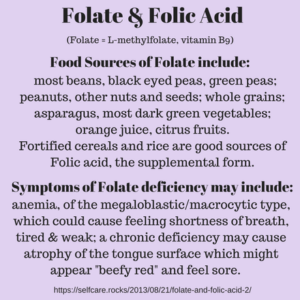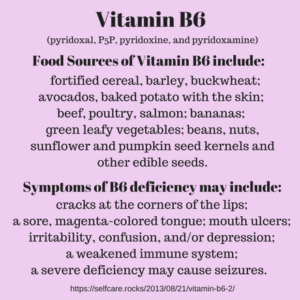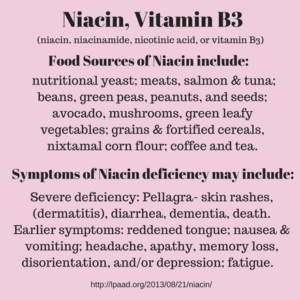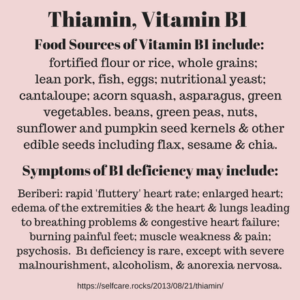Folate (L-methylfolate or vitamin B9) and Folic Acid:
 Food Sources of Folate, the bioactive natural form, include:
Food Sources of Folate, the bioactive natural form, include:
- beans, black eyed peas, green peas,
- peanuts and other nuts and seeds,
- whole grains,
- asparagus, most dark green vegetables,
- orange juice, citrus fruits.
- Fortified cereal and rice are good sources of folic acid, the supplemental form.
Folate is the natural form; Folic Acid is in supplements & fortified foods.
Folate is the form of the vitamin found in food and is more bioactive. Folic acid is the form that is commonly available as a supplement and in fortified foods, however it is less bioactive, less able to function until methyl groups are added which requires adequate supplies of vitamin B12. A genetic difference may exist in some individuals that prevent the body from being able to convert the inactive folic acid form into folate, the methylated bioactive form of the vitamin. [More about methylation.]
Symptoms of Folate deficiency include:
- Deficiency of folate can cause megaloblastic / macrocytic anemia which is characterized by red blood cells that are over-sized and ineffective. Anemia symptoms include being short of breath and feeling tired and weak. The symptoms are due to a shortage of normal red blood cells and reduced ability to transport oxygen with each breath.
- Folate is needed for DNA synthesis and for DNA methylation which may be important for preventing cancerous changes from occurring in the DNA.
- Lack of folate may increase heart disease risks due to less breakdown of homocysteine. Vitamin B6 and B12 are also necessary, a deficiency of any one of the three might cause an accumulation of homocysteine.
- Folate is important during pregnancy for fetal development. Spina bifida and cleft palate are birth defects that may be caused by folate deficiency.
- Deficiency of several of the B vitamin group can cause changes in the appearance and surface texture of the tongue. B vitamins that can cause changes in the tongue are mentioned in the following excerpt and include “niacin (B3), riboflavin (B2), pyridoxine (B6), folic acid (folate/B9), and vitamin B12”:
-
“Deficiencies of niacin, riboflavin, pyridoxine, folic acid, or vitamin B12, resulting from poor diet or from the administration of antagonists, may cause a sore, beefy-red tongue without a coat. In the chronic vitamin deficiency state, the tongue may become atrophic and smooth.” – “The Tongue – Clinical Methods – NCBI bookshelf https://www.ncbi.nlm.nih.gov/books/NBK236/
- See the post on Vitamin B6 for more information about how the group of B vitamins work together in energy metabolism and cell growth.
Reference used for food sources & symptoms of Folate deficiency:
- An Evidence-based Approach to Vitamins and Minerals: Health Benefits and Intake Recommendations, 2nd Ed., by J. Higdon & V. Drake, (Thieme, Stuttgart / New York, 2012)
- A description and source for purchasing the text: http://www.thieme.com/books-main/complementary-medicine/product/1040-an-evidence-based-approach-to-vitamins-and-minerals
- A review of the text: http://ajcn.nutrition.org/content/79/5/892.full
- The text is produced in cooperation with the Linus Pauling Institute. He is a researcher who used large doses of vitamin C to cure cancer tumors. His work was met with skepticism. More recently research supports his work in that a specific type of cancer cells is very susceptible to vitamin C – while to the rest of the body it is water soluble and non-toxic at the level that was toxic to the cancer cells. http://www.sciencedirect.com/science/article/pii/S2213231716302634
Other References used for the food sources of Folate and Folic Acid:
- globalhealingcenter.com/natural-health/folic-acid-foods/
- http://umm.edu/health/medical/altmed/supplement/vitamin-b9-folic-acid
Disclaimer: Opinions are my own and the information is provided for educational purposes within the guidelines of fair use. While I am a Registered Dietitian this information is not intended to provide individual health guidance. Please see a health professional for individual health care purposes.



